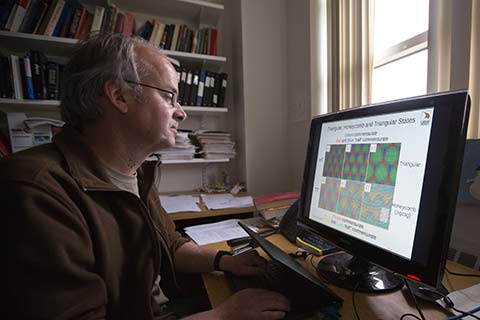
Welcome to the next PoreLab lecture!
Who: Prof. Ken Elder, department of Physics, Oakland University, USA
The research of Prof. Elder is devoted to understanding the complex structures or patterns that emerge in non-equilibrium phenomena. Such patterns are ubiquitous in nature, from double helix structures in DNA to the beautiful array of snowflake shapes. More recently Prof. Elder has worked on the development a phase field model method that resolves microscopic length scales on mesoscopic times scales.
When: Wednesday March 13th at 13:00 (Norway time).
Where:
The lecture will take place Wednesday, 13th March at 13:00 (Norway time). He will give the in-person talk in the Kelvin room (PoreLab Oslo) and the talk will also be streamed in the common room (PoreLab Trondheim). From anywhere else, you will be able to join via the following Zoom link:
https://uio.zoom.us/j/65837085049?pwd=WjZianUyN3FJa2liQkxBbzQrOCtGdz09
Title: Defect structures and patterns in ultrathin layers
Abstract:
In this talk I would to discus modeling out of plane deformation in two dimensional sheets and bilayers of such sheets. In particular the focus will be on graphene and hexagonal boron nitride (hBN). As proof of principle the model is shown analytically to reduce to standard models of flexible sheets in the small deformation limit. Applications to strained sheets, dislocation dipoles and grain boundaries are used to validate the behavior of a single flexible graphene layer. For the multi-layer systems, parameters are obtained to closely match existing theoretical density functional theory calculations on layer spacing and stacking energies for graphene/graphene, hBN/hBN and graphene/hBN bilayers. Simulations of graphene/hBN twisted bilayers are presented
that reveal the structure, energy, and elastic properties of the corresponding Moire patterns, and show a crossover, as the misorientation angle between the layers increases, from the well-defined hexagonal network of domain boundaries and junctions to smeared-out patterns. The transition occurs when the thickness of domain walls approaches the size of the Moire patterns, and coincides with the peaks in the average von Mises and volumetric stresses of the bilayer
